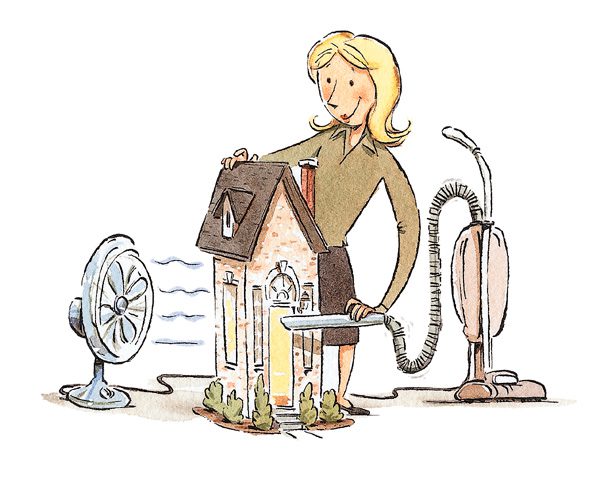Small lifestyle changes can make a big difference in just a little time, say BYU researchers.
The clap of the professor’s wing-tipped dress shoes echoes down the sanitized hallway and reaches into open doorways. Led by a physician, he notices that room after room is filled with patients, some with visitors, some alone, some watching TV, some sleeping, and some staring at the ceiling or wall; all are suffering from chronic illnesses, such as heart disease, cancer, and diabetes.
“What caused these people to get to this point in their lives?” the professor asks the physician in hushed tones. The doctor’s inconclusive answer was troubling, and the professor thought to himself, “We are treating conditions, but we don’t know where they are coming from.”
That bleak exposure to chronic disease in an Illinois hospital six years ago was a catalyst for Steven G. Aldana (BS ’86), professor of exercise science, to discover the reasons for this increasing problem. Ray M. Merrill (BA ’86), professor of health science and a coresearcher with Aldana, says, “Historically, the main causes of death in the United States were due to infectious diseases. The challenge was to isolate a single bacteria, virus, or parasite. As improvements were made to better control infectious disease, there was a parallel emergence of chronic diseases. Today chronic disease and conditions explain most of what kills us.”
Their research in the past six years has pointed Aldana and Merrill to lifestyle choices as the culprit in most cases; what’s more, a recent study has shown that even simple changes in lifestyle can improve lives and significantly reduce a person’s risk of chronic disease—in only a few weeks.
“The study shows that in as little as six weeks, if you make some changes, really good things can happen,” says Aldana. The research underscored for the researchers and the study participants how much control individuals have over important aspects of their own health. “Obviously, we are going to die,” he says, “but when and of what are up for debate. For those who have a healthy diet and exercise regularly, it is possible to extend life by 10–20 years.”
Lessons in Lifestyle

Running partners Steven Aldana (left) and Ray Merrill practice what they preach about the importance of eating healthy food and exercising. Their research has shown that relatively minor lifestyle changes can result in a major reduction of risk factors for chronic disease in as little as six weeks. Photo by Bradley Slade.
To better understand the relationship between lifestyle and chronic disease, Aldana and Merrill enlisted the help of 337 volunteers, ages 43 to 81, in Rockford, Ill. The participants took a 40-hour course over a four-week period and learned about such topics as health myths, coronary risk factors, obesity, diabetes, hypertension, cancer, exercise, and lifestyle choices. Dietetic and medical professionals stressed the importance of adopting a food-as-grown diet of grains and fresh fruits and vegetables. They also learned about diets that are low in saturated and trans fats, sugar, and salt while high in fiber and antioxidants.
Participants in the study were also coached on making smart decisions when buying food. Many joined dieticians on scheduled trips to the grocery store to learn how to select healthy foods. Area restaurants that serve healthier options also provided menus to the volunteers.
In addition, researchers encouraged participants to implement an exercise program of walking and general fitness for 30 minutes on most, if not all, days of the week. Those 30 minutes didn’t have to be high-intensity exercise, and they could be broken up into smaller amounts of time over a few sessions each day.
Armed with facts and resources for healthy living, the participants were then challenged to implement what they had learned in their daily health decisions. At regular intervals, the researchers have reviewed the participants’ lifestyle changes and gathered data on their health. They will monitor the participants for a total of two years.
After the initial checkups, the researchers were gratified by the lifestyle changes the participants reported making in their lives. The number of participants who ate five servings of fruits and vegetables per day had doubled. Pedometer data revealed that, on average, program participants increased their daily number of steps by 30 percent. And such changes, even after only a short time, showed in their overall health.
“We’ve had some startling results here,” says Roger L. Greenlaw, medical director of SwedishAmerican Health System in Rockford, Ill., who participated in the study and spoke to the participants during their classes. Published in March 2005 in the Journal of the American Dietetic Association, the study revealed that after just six weeks the percentage of participants with hypertension dropped from 18.5 to 7.5 percent. Twelve participants were able to decrease their blood-pressure medication during the intervention. At the beginning of the study 21 participants were diabetic, according to their blood sugar levels; in just six weeks the number of diabetics had dropped to 13.
The study showed that participants were able to reap the benefits of exercise through low-intensity workouts without the presence of pain. The secret was to find physical activities that were enjoyable.
Taking Control
“People can take control of their health through their own actions and not be dependent on medicines, if they want to,” says Greenlaw. “The problem is a lot of people don’t believe that is possible; they don’t believe that what they eat is really going to make that much of a difference. If they have a problem, they think they need medication, not shifting what they eat and how they exercise.”
Merrill says that, while many factors, like genetics, influence a person’s health, most of them are within that person’s control. “What percent of cancer do you think is related to heredity? About 20,” he says. “So about 80 percent of cancers are lifestyle related.”
The researchers say that, despite the rising costs of healthcare in the United States, lifestyle adjustments are within reach of any budget. “We have a solution to about 70 percent of what goes wrong with us—by just changing what we are doing,” says Greenlaw. “For people who don’t have any money and for people who have a lot of money, the prevention, arrest, and reversal interventions are equally available.”
Exercise and eating nutritious meals are not trends, say the researchers, so they are likely to last. “These are really simple things, but that’s why they are so successful,” says Aaron M. Hardy (BS ’97), wellness coordinator for Washoe School District in Nevada who was a coresearcher in another study with Aldana and Merrill that considered the effects of health promotion in the workplace. After creating a general health wellness program for its some 8,700 employees, Hardy’s school district has seen a 7 percent decrease in the district’s healthcare costs and absenteeism, which has amounted to an estimated savings of $3.8 million over three years.
Despite examples of health promotion and individual efforts to revamp lifestyle, Aldana says that much of America has yet to catch the vision. “We are fatter now than at any other point in human history; we have more diabetes now than in any other time in human history. Whatever we have been doing in the past is not working,” says Aldana.
In an attempt to extend his message to a lay audience, Aldana has written The Culprit and the Cure, published in 2005. His book shares the same principles taught to the participants in Rockford. He hopes the book and his research will encourage readers by showing them how attainable good health can be and how it can improve the quality and increase the length of their life.
“Do you want to spend time with grandkids or not?” Aldana asks. “That’s what it boils down to. Do you really want to be actively involved in church, community, and the lives of grandchildren for 10–20 years? Then you need to make some changes.”
More information about Steven Aldana’s book, The Culprit and the Cure, can be found at culpritandcure.com.
10 Easy Ways to Improve What You Eat

Photo by Michael Stanfill
Want to make some dietary changes but not sure where to start? In his book on healthy living, The Culprit and the Cure, BYU professor of exercise science Steven G. Aldana (BS ’86) says the following small changes will go a long way to improving your eating and health.
1. Drink fat-free milk instead of whole milk.
2. Drink a glass of water before a meal.
3. Eat leaner red meat and poultry.
4. Share your restaurant meal with your spouse or a friend.
5. Use vegetable oils instead of solid fats.
6. Eat before shopping for groceries.
7. Have fruit for dessert.
8. Eat before you get too hungry, and don’t skip meals.
9. Try brown rice or whole-wheat pasta.
10. Avoid food portions larger than your fist.
Simple Ways to Stay Fit

Photo by Bradley Slade
Tired of walking the same route every day or exercising to the same aerobics video? Or does taking on a daily exercise routine seem too daunting? The good news, according to exercise science professor Steven G. Aldana (BS ’86) and health science professor Ray M. Merrill (BA ’86), is that exercise can come in a variety of ways and at various levels of intensity. Below is a list of moderate-intensity activities that Aldana recommends in his book The Culprit and the Cure. Activities are ranked, top to bottom, in order of intensity, with recommended time lengths. (This information is taken from a longer list of recommendations from the Centers for Disease Control.)
Stair walking: 15 min.
Shoveling snow: 15 min.
Jumping rope: 15 min.
Playing basketball: 15–20 min.
Swimming laps: 15–20 min.
Engaging in water aerobics: 30 min.
Raking leaves: 30 min.
Pushing a stroller 1.5 miles: 30 min.
Walking 1.75 miles: 35 min.
Gardening (standing): 30–45 min.
Washing windows or floors: 45–60 min.
Washing and waxing a car or boat: 45–60 min.









